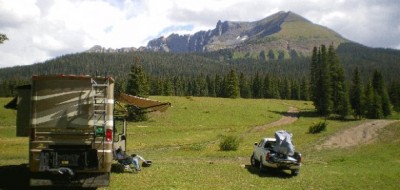By Bob Difley
 Many RV snowbirds are just now arriving in the Southwestern Deserts, with quite a few heading for Quartzsite, Arizona to “boondock” on Bureau of Land Management (BLM) Land.
Many RV snowbirds are just now arriving in the Southwestern Deserts, with quite a few heading for Quartzsite, Arizona to “boondock” on Bureau of Land Management (BLM) Land.
The BLM has established what they call Long Term Visitor Areas (LTVAs) to provide RVers with open space for camping without the hookups you find in established campgrounds. The LTVAs are an easy and effective introduction to desert boondocking and snowbirding. Support services (such a a dump station, a communal water supply source, and dumpsters for trash) and supplies and services are available nearby. The great gathering of veteran RV boondockers, akin to the mountain man rendezvous of 200 years ago, stands ready to help out if needed.
However, plenty more snowbird/boondocking possibilities exist outside the LTVAs of Quartzsite in the Mojave Desert of Southeastern California (including some LTVAs in California just west of Yuma) and the Sonora Desert of Southwestern Arizona. After you have tested your desert mettle in an LTVA you might want to try one of these lesser known snowbirding opportunities.
You will find the main mid-winter snowbirding locations at the lowest elevations: around Yuma on both sides of the Colorado River, in California west along the Mexican border, up the Colorado River including the Parker Strip and around Lake Havasu, east toward Phoenix and down to Tucson. Low elevation desert camping is also available around Deming in New Mexico. The rest of Mexico is higher elevation, over 2,000 feet, and therefore colder, as are the northern and southeastern parts of Arizona, though many snowbirds gather around Benson and Willcox.
 To make your job of finding dispersed boondocking campsites easier, visit one of the regional offices of the BLM where they can provide you with both designated and undesignated camping areas. You may find the designated camping areas buzzing with ATVs, especially on weekends, and decide to try elsewhere.
To make your job of finding dispersed boondocking campsites easier, visit one of the regional offices of the BLM where they can provide you with both designated and undesignated camping areas. You may find the designated camping areas buzzing with ATVs, especially on weekends, and decide to try elsewhere.
You can camp anywhere on BLM land where you have access to an appropriate campsite. The access roads, mostly of mixed hard sand and rock, vary in their condition and are not regularly repaired or graded.
But wherever you are not blocking a road, and where you are not expressly prohibited from camping by signs or fences, go ahead and stake your claim. (You can find more information on desert boondocking in my ebook, Snowbird Guide to Boondocking in the Southwestern Deserts, available in either PDF or Kindle.)
I suggest that you at first pick one of the boondocking areas where other boondockers are present, as this will tell you that conditions like access roads and a hard and level parking surface are available. Though these locations tend to be more crowded, you may find a nice quiet spot and you may feel more secure with others around.
When your confidence—or the noise level from ATVs and generators–rises, then go seeking your own back road and explore for your secret boondocking spot. You will find dirt roads heading off into the desert almost anywhere you are driving. And if you look close enough you may spot an RV or two sitting out there in the distance under a mesquite tree. Also, ask your neighbors and other RVers where they have found good quiet and uncrowded spots. They may even tell you.
For more RVing articles and tips take a look at my Healthy RV Lifestyle website, where you will also find my ebooks: BOONDOCKING: Finding the Perfect Campsite on America’s Public Lands (PDF or Kindle), 111 Ways to Get the Biggest Bang for your RV Lifestyle Buck (PDF or Kindle), and Snowbird Guide to Boondocking in the Southwestern Deserts (PDF or Kindle), and my newest, The RV Lifestyle: Reflections of Life on the Road (Kindle reader version). NOTE: Use the Kindle version to read on iPad and iPhone or any device that has the free Kindle reader app.


